Layers Overview
|
- To open the Layers, click the Layers icon from the Main Toolbar.
- To toggle a layer on or off, click the layer. The Blue Check
 means the layer is turned on. means the layer is turned on.
- To move a layer to another position in the Layers, drag and drop it.
- To create a Group Name for related layers, such as the Property Data group, see the Options Menu section below.
- To style a layer, see Thematic Mapper in Related Documents.
|
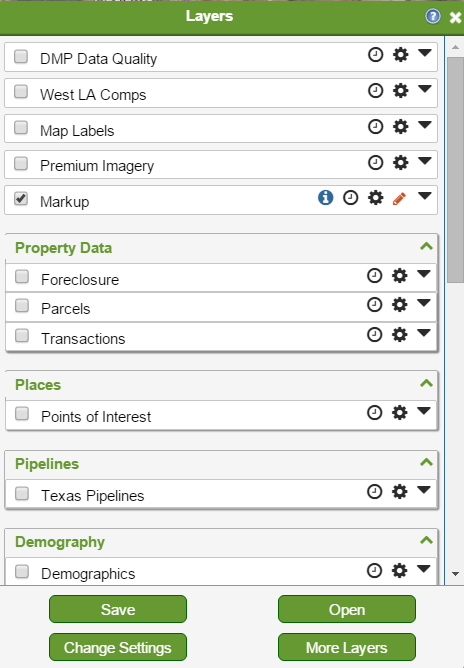
|
Adding Layers
Removing Layers, Clearing Layers and Deleting Layers
Options Menu
|
This section describes these options on the Options menu:
- Create Label
- Layer Properties
- Save As...
- Save a Copy As...
- Zoom to Bounds
Note: For information about Remove Layer, see the section above: Removing Layers and Deleting Layers.
See Related Documents for information about these options:
- Create New Filter: Create Custom Search Filters
- Edit Style: Thematic Mapper
- Extract: Extract Layer to Shapefile
|
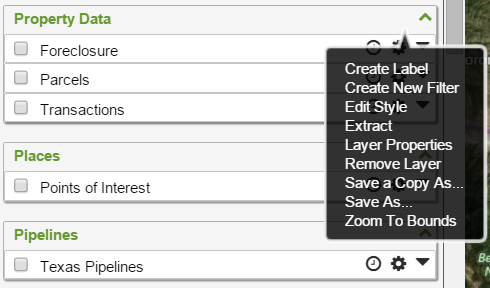
|
Create Label
The Create Label option creates a label layer. A label layer displays a label for every feature on the map associated with a selected field in your database.
Tip: It is the best practice to review the values of the fields in your database before creating a label layer.
- Click the Options icon
 on the layer you would like to label. The Options menu appears. on the layer you would like to label. The Options menu appears.
- Click Create Label on the menu.
- Select a Field in your database from the drop-down list that contains the values you would like to appear as labels. In the example to the right, the values of the Neighborhd field are the names of neighborhoods.
- Click the OK button. The map displays the labels, and Layers displays the label layer with the name of your selected Field. In the example label layer to the right, the field is Neighborhd.
Tip: It is the best practice to keep a label layer and its corresponding data layer together in Layers.
- To edit the style of the labels on the map, such as changing the fill or line color, select Edit Style from the Options menu.
|
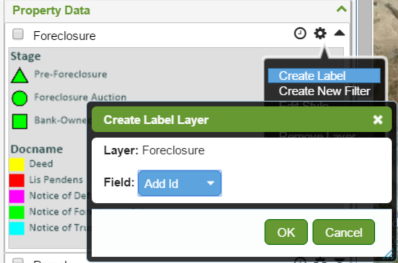
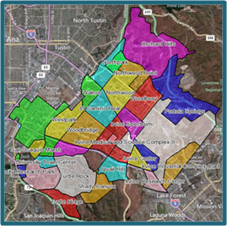
|
Layer Properties
- Click the Options icon
 on a layer to view, enter, or edit its properties. The Options menu appears. on a layer to view, enter, or edit its properties. The Options menu appears.
- Click Layer Properties on the menu. The Layer Settings window appears.
- Select your desired options in the Layer Settings window. Your selections are not enabled until you click OK at the bottom of the window.
- Title: Edit the layer name here if desired.
- Abstract: The best practice is to enter a description of the layer data.
- Attribution: The best practice is to enter details such as who loaded the layer data, the date the data was loaded, and the source of the data.
- Group Name: Groups conveniently bring together related layers, such as the Property Data Group. There are three options for Group Name:
- Select an existing Group Name from the drop-down list. Your selected layer moves to the Group.
- Select New from the drop-down list to create a new Group for your selected layer. The Create New Group box appears. Enter a new Group Name and click OK.
Layers displays a new green group header with your new Group Name. Your selected layer is listed under the group header.
- Select None from the drop-down list to remove your selected layer from its Group. The layers menu displays the layer without a Group.
|

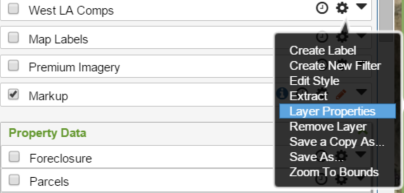
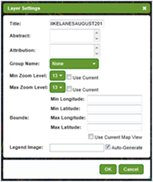

|
- Min / Max Zoom Level: The Zoom Level range is 1 to 21. The best practice is to set the Max Zoom Level to 21 (zoomed in all the way). It allows you to view the layer at the greatest detail (the parcel level). The Min Zoom Level is 1 (zoomed out to the furthest extent from the map surface).
The Use Current option sets the current map extent as the zoom level. Select Use Current for the Min or Max Zoom Level by clicking the appropriate check box. The zoom level in the drop-down box is grayed out.
Note: If you zoom out of the map past your selected Min Zoom Level:
- If you zoom out too far the layer will fade out.
- The base map is in view, but the features of your layer are not in view. This would occur, for example, if the Min Zoom Level was set to 18, and you zoomed out to the County (level 10 or 11). To view the information you would need to zoom in closer.
|

|
- Min / Max Longitude and Latitude: Instead of entering map coordinates, the best practice is to select Use Current Map View by clicking the check box.
This option sets specific bounds in which your layer is visible. For example, you might use this option to set bounds for the display of a watersheds layer to your City instead of the whole state of California. It would aid in viewing the layer and speed up the display of the layer.
- Layers Image: Use this option to place an image on any layer listed in Layers. This enables quick understanding of the layer. For example, you might place an image of a bike on a bike path layer. The image is displayed only on the layer listed in the Layers menu.
- Uncheck Auto-Generate to enable your image upload. Auto-Generate displays a default image for a layer if there is one.
- Click in the Layers Image field to enter the path to an image file.
|
Save As
Use this option to save a layer to a different folder. For example, you could save a layer in your User folder to your Group_Folder, such as the Public Works Group. The people in your group would then be able to access your layer.
Note: You must have the appropriate account permission to use this option.
Tip: If this option is not enabled, contact your Account Administrator.
|
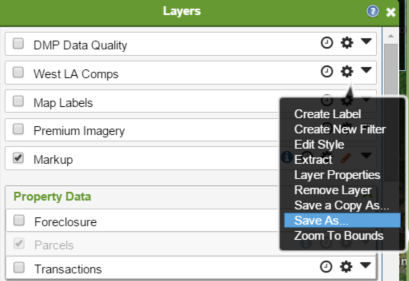

|
- Click the Options icon
 on a layer that you would like to save to a different folder. The Options menu appears. on a layer that you would like to save to a different folder. The Options menu appears.
- Click Save As on the menu. The Save Layer As window appears.
- Select the folder to save your layer from the Folder drop-down list.
- Click the Save button.
Save a Copy As
This is an Administrator feature.
Zoom to Bounds
- Click the Options icon
 on a layer to zoom to its bounds. The Options menu appears. on a layer to zoom to its bounds. The Options menu appears.
- Click Zoom to Bounds on the menu. The map screen zooms to the bounds of the features on the layer.
Note: The Min / Max Zoom Level settings may affect the display of layer features. See Min / Max Zoom Level above for details.
|
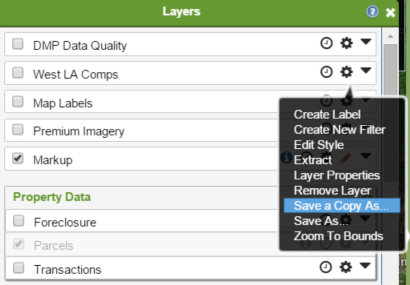
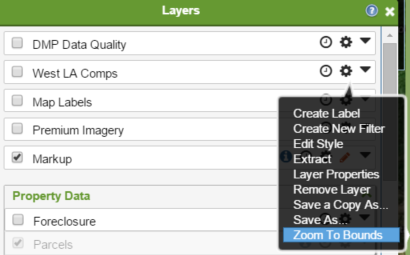
|
Layer Icons
|
This section describes the functions of the layer icons:
- Identify

- View in Time

- Options
 : See the section above, Options Menu, for information. : See the section above, Options Menu, for information.
- Out of Zoom Range: Your layer appears faded if you zoom beyond your selected Max Zoom Level. See Min / Max Zoom Level
above for information.
Identify Icon: Identifying a Layer
Click on the Identify icon to toggle it on and off. A clearly visible i  on the icon means that the layer is identified. A faded white i on the icon means that the layer is identified. A faded white i  means that identify is off. means that identify is off.
You should identify a layer when you would like information about the features of the layer. An information window appears when you click on a feature of an identified layer. The layer must also be turned on, displaying a Blue Check  . .
In the example to the right, the Parcels layer is turned on and identified. As a result, a Parcel Details window appears when you click on any parcel.
Note: When there are two or more identified layers at a location on the map that you have clicked, the Notification icon  displays at the top right corner of LandVision. displays at the top right corner of LandVision.
- Click the Notification icon
 to open a menu that lists the identified layers. to open a menu that lists the identified layers.
- Select the layer you would like to work on by clicking on it. In the example to the right, ParcelDetail and SchoolDistrict are the listed identified layers.
View in Time Icon
Use the View in Time option  to view your selected layer at an earlier time. This is very useful to understand the changes that may have been made to the layer. to view your selected layer at an earlier time. This is very useful to understand the changes that may have been made to the layer.
- Click the View in Time icon
 on your desired layer. The View in Time box appears. on your desired layer. The View in Time box appears.
- Click in the Time field. A drop-down box opens with a calendar and sliders to set the time.
- Select your desired date and time to view your layer:
- To select a month/year, click the left or right arrows in the calendar heading.
- To select a day, click on it.
Note: If you do not select a time, it is set to 12:00:00 AM by default.
- To select the Hour, Minute, or Second, use the appropriate slider.
- To reset the Time field to the current date and time, click the Now button.
- To clear the Time field, click the Clear button in the View in Time box.
- Click the Done button when you have set your desired date and time. The drop-down box disappears.
- Click OK in the View in Time box to view your layer at the selected date and time.
To return your layer view to the current date and time:
- Click the View in Time icon
 on your layer. The View in Time box appears. on your layer. The View in Time box appears.
- Click in the Time field. A drop-down box opens with a calendar and sliders to set the time.
- Click the Now button.
- Click the Done button. The drop-down box disappears.
- Click Ok in the View in Time box.
|

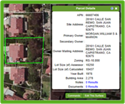

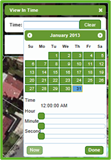
|
Setting up Map Themes
|
Creating Map Themes enables you to consistently return to a map view with only the map layers, styles, and settings relevant to a specific project. For example, if you're working on a project concerning Parks and Recreation, you might create a Map Theme with layers displaying bike lanes and trails. You might not create the Map Theme with a layer showing manholes.
You have many options for editing the look and feel of the data that is displayed in each Map Theme. Each individual Map Theme can have its own unique set of layers, styles, order, controls, and features. When you save a Map Theme it includes all your current settings in LandVision. There is no limit on the number of Map Themes that you can create.
The following example workflow is intended to increase your understanding of Map Themes.
- Click the Open button at the bottom of Layers. The Open Map Views window appears.
Note: Home is the default Map Theme set up by your Administrator. It is the best practice not to overwrite the Home Map Theme.
- Select Production from the Folder drop-down list.
- Select Home in the Available list.
- Click OK. This enables access to the list of layers that are currently displayed in the Home Map Theme. You access these layers later in this workflow.
- Click the Save button at the bottom of the Layers. The Save As box appears.
- Perform the following in the Save As box:
- Folder: Select the User folder.
- Name: Enter Parks as the name to save this Map Theme. (Let us assume for this example we are working on creating a Parks Map Theme.)
Tip: Saving the Map Theme to your USER folder allows you to make edits and changes to the Map Theme and get any final approvals before sharing this information to all users in the Production folder.
- Click the More Layers button at the bottom of Layers to add any desired layers now in the Production folder to the Layers menu. The Browse Layers window appears. See the section above, Adding Layers for instructions.
- With all layers now added to the Parks Map Theme, you can begin grouping the layers and setting the view status. See Layer Properties above for instructions.
Tip: LandVision allows you to define whether a layer is automatically On or Off when the Map Theme is loaded, as well as whether the layer is identified.
Tip: LandVision utilizes Autosave functionality. When you exit, and then log back into the application, it zooms to the last map view, including the same Map Theme.
- At this point in the workflow:
- You could Share this Map Theme with another user for approval. OR,
- You could Save this Map Theme to the Production Folder to provide access to anyone in the agency.
Here is how you would Share the Map Theme:
- Save the Map Theme to the Share folder.
- Instruct the other user to click the Open button at the bottom of Layers, and then navigate to the Share folder where the file you saved is located.
- The other user can make additional changes to the Map Theme and either overwrite the changes or save them with a different name.
Once the Map Theme is approved, it can to be saved to the Production folder for anyone in the agency to access it.
Here is how you would save the Map Theme directly to the Production folder:
- Click the Save button at the bottom of Layers and select the Production folder.
- Name the Map Theme and click Save.
Now anyone in the agency has access to this new Map Theme.
|
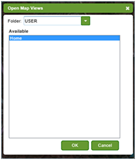

|
Change Settings
The Change Settings button at the bottom of Layers is for Administrators Only.
Warning: Do not use this feature unless you understand folder levels and account permissions in LandVision.
|
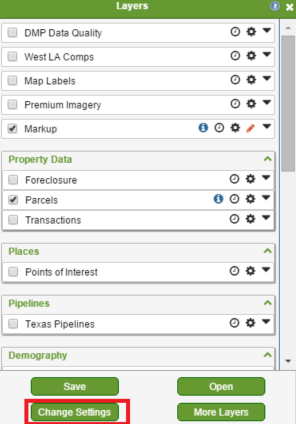
|
Related Information
|

